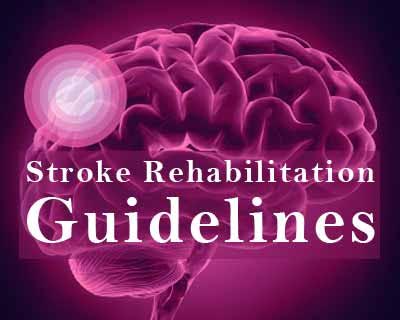- Home
- Editorial
- News
- Practice Guidelines
- Anesthesiology Guidelines
- Cancer Guidelines
- Cardiac Sciences Guidelines
- Critical Care Guidelines
- Dentistry Guidelines
- Dermatology Guidelines
- Diabetes and Endo Guidelines
- Diagnostics Guidelines
- ENT Guidelines
- Featured Practice Guidelines
- Gastroenterology Guidelines
- Geriatrics Guidelines
- Medicine Guidelines
- Nephrology Guidelines
- Neurosciences Guidelines
- Obs and Gynae Guidelines
- Ophthalmology Guidelines
- Orthopaedics Guidelines
- Paediatrics Guidelines
- Psychiatry Guidelines
- Pulmonology Guidelines
- Radiology Guidelines
- Surgery Guidelines
- Urology Guidelines
Guidelines for Rehabilitation after Stroke- AHA/ASA 2016

Stroke rehabilitation requires a sustained and coordinated effort from a large team, including the patient and his or her goals, family and friends, other caregivers (eg, personal care attendants), physicians, nurses, physical and occupational therapists, speech-language pathologists, recreation therapists, psychologists, nutritionists, social workers, and others. Communication and coordination among these team members are paramount in maximizing the effectiveness and efficiency of rehabilitation and underlie this entire guideline. Without communication and coordination, isolated efforts to rehabilitate the stroke survivor are unlikely to achieve their full potential.
Recently, in May 2016, American Heart Association/American Stroke Association have issued guidelines Guidelines for Adult Stroke Rehabilitation and Recovery- A Guideline for Healthcare Professionals From the American Heart Association/American Stroke Association. The guidelines are comprehensive and cover all aspects of rehabilitation of a stroke patient in the hospital setting. Some of the recommendations are as follows:-
Rehabilitation Interventions in the Inpatient Hospital Setting
- It is recommended that early rehabilitation for hospitalized stroke patients be provided in environments with organized, inter professional stroke care.
- It is recommended that stroke survivors receive rehabilitation at an intensity commensurate with anticipated benefit and tolerance.
- High-dose, very early mobilization within 24 hours of stroke onset can reduce the odds of a favorable outcome at 3 months and is not recommended.
Prevention and Medical Management of Comorbidities
- During hospitalization and inpatient rehabilitation, regular skin assessments are recommended with objective scales of risk such as the Braden scale.
- It is recommended to minimize or eliminate skin friction, to minimize skin pressure, to provide appropriate support surfaces, to avoid excessive moisture, and to maintain adequate nutrition and hydration to prevent skin breakdown. Regular turning, good skin hygiene, and use of specialized mattresses, wheelchair cushions, and seating are recommended until mobility returns.
- Patients, staff, and caregivers should be educated about the prevention of skin breakdown.
- Positioning of hemiplegic shoulder in maximum external rotation while the patient is either sitting or in bed for 30 minutes daily is probably indicated.
- Resting hand/wrist splints, along with regular stretching and spasticity management in patients lacking active hand movement, may be considered.
- Use of serial casting or static adjustable splints may be considered to reduce mild to moderate elbow and wrist contractures.
- Surgical release of brachialis, brachioradialis, and biceps muscles may be considered for substantial elbow contractures and associated pain.
- Resting ankle splints used at night and during assisted standing may be considered for prevention of ankle contracture in the hemiplegic limb.
Prevention of Deep Venous Thrombosis
- In ischemic stroke, prophylactic-dose subcutaneous heparin (UFH or LMWH) should be used for the duration of the acute and rehabilitation hospital stay or until the stroke survivor regains mobility.
- In ischemic stroke, it is reasonable to use prophylactic-dose LMWH over prophylacticdose UFH for prevention of DVT.
- A In ischemic stroke, it may be reasonable to use intermittent pneumatic compression over no prophylaxis during the acute hospitalization.
- In ICH, it may be reasonable to use prophylactic-dose subcutaneous heparin (UFH or LMWH) started between days 2 and 4 over no prophylaxis.
- In ICH, it may be reasonable to use prophylacticdose LMWH over prophylactic-dose UFH.
- In ICH, it may be reasonable to use intermittent pneumatic compression devices over no prophylaxis.
- In ischemic stroke, it is not useful to use elastic compression stockings.
- In ICH, it is not useful to use elastic compression stockings.
Treatment of Bowel and Bladder Incontinence
- A history of urological issues before stroke should be obtained.
- Assessment of urinary retention through bladder scanning or intermittent catheterizations after voiding while recording volumes is recommended for patients with urinary incontinence or retention.
- Assessment of cognitive awareness of need to void or having voided is reasonable.
- Removal of the Foley catheter (if any) within 24 hours after admission for acute stroke is recommended.
- It is reasonable to use the following treatment interventions to improve bladder incontinence in stroke patients:
- Prompted voiding
- Pelvic floor muscle training (after discharge home)
- It may be reasonable to assess prior bowel function in acutely hospitalized stroke patients and include the following:
- Stool consistency, frequency, and timing (before stroke)
- Bowel care practices before stroke
There are more guidelines related to balance, Ataxia, Spacticity, Mobility, motor speech disorders and many more
For detailed guidelines, click on the following link
http://stroke.ahajournals.org/content/early/2016/05/04/STR.0000000000000098.full.pdf
Next Story
NO DATA FOUND

Disclaimer: This site is primarily intended for healthcare professionals. Any content/information on this website does not replace the advice of medical and/or health professionals and should not be construed as medical/diagnostic advice/endorsement or prescription. Use of this site is subject to our terms of use, privacy policy, advertisement policy. © 2020 Minerva Medical Treatment Pvt Ltd